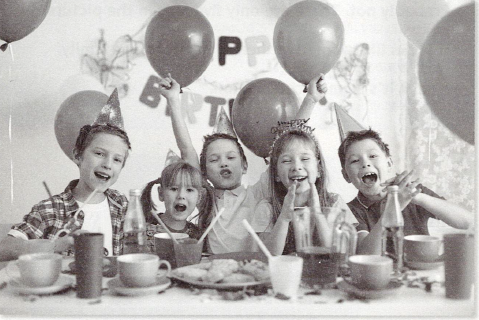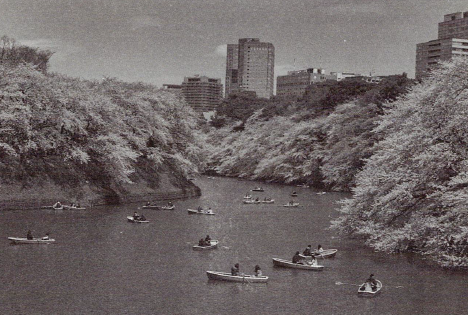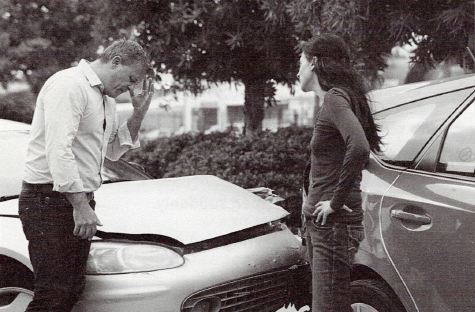<レッスンの流れ>
- 受講者は写真について説明します。短文だけでなく、複合文を作るようにしましょう。
- 講師は受講者の説明を聞きながら、訂正や言い換えなどのアドバイスをします。
- 受講者の説明が一通り終わったら、写真について講師が質問しますので、回答してください。
<Flow of the Lesson>
- Student should describe the picture, not only with short sentences but also by constructing complex sentences.
- The instructor will listen to the students’ descriptions and provide advice on corrections, paraphrasing, and other aspects.
- Once the student have finished their descriptions of the picture, the instructor will ask questions about it, which the student should answer.
Sample 1 「 A Birthday Party」
Speech 1
This picture shows a birthday party. It looks like these kids are
about elementary-school age. It’s probably not a very big party,
because there are only five children in the picture. The party
could be at a restaurant. Or, it might be at one of the kids’
houses.
Speech 2
Only four of the children are wearing hats. All five of them are laughing,
though. I wonder whose birthday it is. It’s hard to tell. Perhaps the one
in the middle. Certainly, they are all having a good time.
Speech 3
There are several bottles of sodas on the table. Some coffee
cups are in front of the bottles. This is strange, since children
don’t usually drink coffee. It’s possible the cups were for soup.
However, the picture doesn’t show the most important thing, a
cake!
Question 1 :
What does the picture show?
• The picture shows a birthday party.
• The picture shows children laughing.
• The picture shows a group of kids at a table.
Question 2 :
Where do you think the party is (at)?
• The party could be at a restaurant.
• It could be at one of the kids’houses.
• Maybe the party’s at the birthday boy/girl’s house.
Question 3 :
Is it a big party?
• Probably not. There are only five kids in the picture.
• It looks like a small gathering of friends or family.
• I think it’s a small celebration.
Question 4 :
Whoses birthday is it?
● It’s hard to tell.
● Perhaps the one in the middle.
● I’m not sure.
Question 5 :
What’s on the table?
● There are several bottles of soda on the table.
● Some coffee cups are in front of the bottles.
● There is a plate of food in the center.
Sample 2 「Cherry Blossom Viewing」
Speech 1
In this picture, people are boating on a river or a lake. It must
be spri ng, because the cherry blossoms are in bloom. Most of
the people in the boats are couples. Many of them are likely on
date. The boats are all the same size and shape, so they are almost
certainly rental boats.
Speech 2
It’s a very nice day. The sun is shining brightly. It looks a little
chilly, because most of the people are wearing jackets or sweaters.
There are only a few clouds in the sky. What a relaxing way to spend the day!
Speech 3
This park is definitely in 」apan. It’s li kely somewhere in Tokyo,
since there are tall buildings in the background. Cherry blossomviewing
is an important tradition in 」apan. My friends and I enjoy
hanami every year. There’s a great place near my office.
Question 1 :
What are the people in the picture doing?
● People are boating on a river or a lake.
● They are enjoying the cherry blossoms.
● They are spending the day in a park.
Question 2 :
What season is it?
• It must be spring.
• It’s probably spring.
•lt looks like it is March or April.
Question 3 :
What is the w eather like?
• The sun is shining brightly.
• It’s a clear day.
• It looks a little chilly.
Question 4 :
Whereistheparklocated?
• This park is definitely in Japan.
• It’s probably in a city.
• It’s likely somewhere in Tokyo.
Question 5 :
Do you ever go cherry-blossom viewing?
• Of course. My friends and I go every year.
•Absolutely.I usually go with my co-workers.
•Certainly. There’s a great place near my office.
Sample 3 「A Fender-bender」
Speech 1
It appears these people were in a car accident. The woman looks
angry. She has her hands on her hips. The man seems apologetic.
It’s not snowing or raining, so I don’ t think bad weather caused
the accident.
Speech 2
The man’s car is badly damaged. The picture doesn’t show the
woman’s car clearly. I think it was the man’s fault. Maybe the
man was following too closely. Perhaps the woman stopped suddenly.
Then again, the man was possibly texting and driving.
Speech 3
It looks like it was a minor accident. Neither of them seem injured.
The man’s car is badly damaged. I imagine they will call a
tow truck. The police will probably give the man a ticket. Surely,
both of them wish this didn’t happen.
Question 1 :
What are these people talking about?
● It appears these people were in a car accident.
● It looks like they had a traffic accident.
● Obviously, there was an accident.
Question 2 :
How do you think they feel?
• The woman looks angry.
• The man seems apologetic.
• Both of them must be unhappy.
Question 3 :
Whose fault was it?
• It was probably the man’s fault.
• I think it was the man’s fault.
• The man’s (fault), since he was behind her.
Question 4 :
Was it a bad accident?
• It looks like it was just a minor accident.
• No. Neither of them seem injured.
• No, because the lady’s car isn’t badly damaged.
Question 5 :
What do you think will happen next?
• They’ll likely call the police.
• I imagine they’ll call a tow truck.
• They’ll probably share insurance information.










